injector programming RENAULT KANGOO 2013 X61 / 2.G Diesel DCM 1.2 Injection Workshop Manual
[x] Cancel search | Manufacturer: RENAULT, Model Year: 2013, Model line: KANGOO, Model: RENAULT KANGOO 2013 X61 / 2.GPages: 204, PDF Size: 0.99 MB
Page 11 of 204
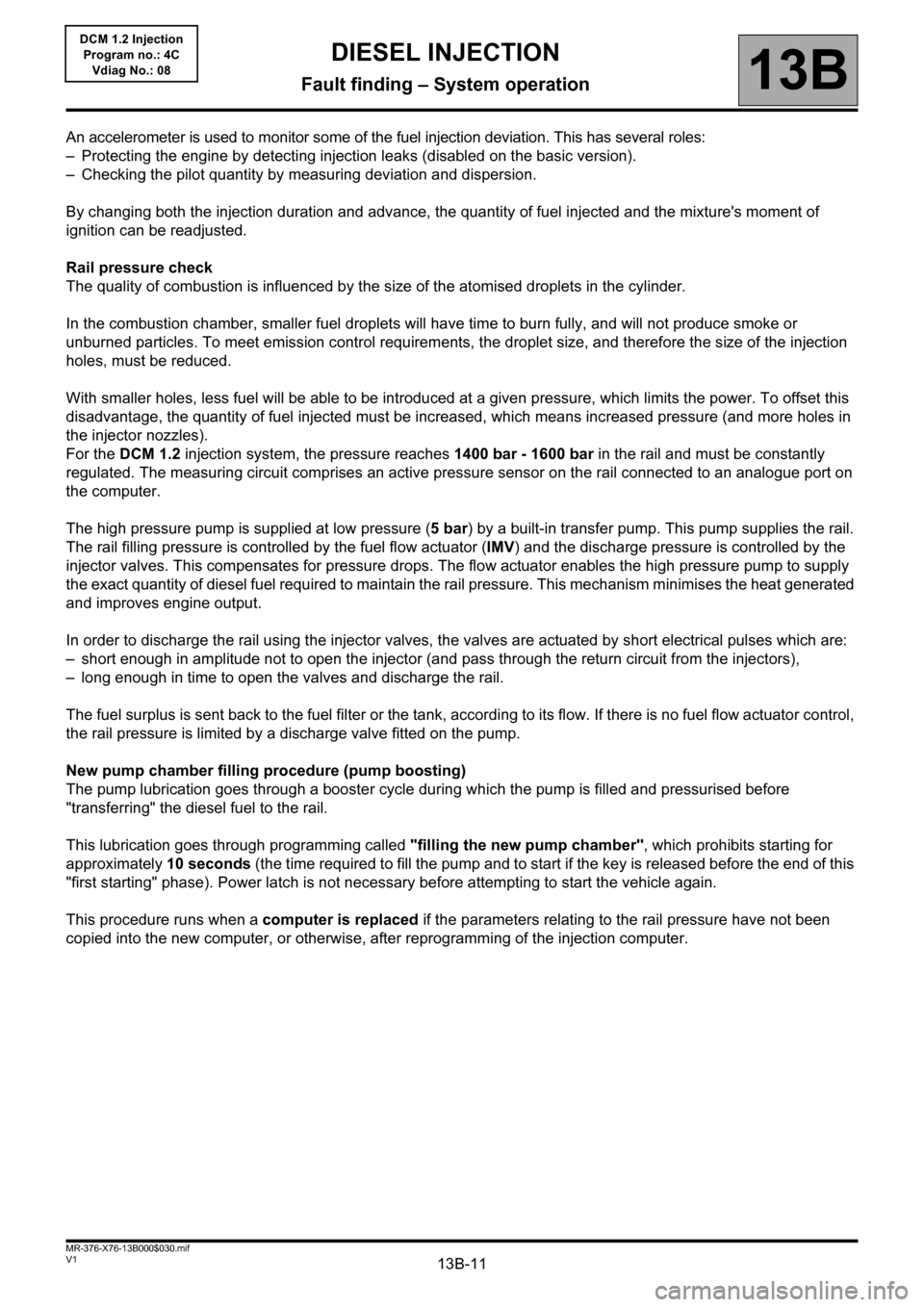
13B-11V1 MR-376-X76-13B000$030.mif
DIESEL INJECTION
Fault finding – System operation13B
DCM 1.2 Injection
Program no.: 4C
Vdiag No.: 08
An accelerometer is used to monitor some of the fuel injection deviation. This has several roles:
– Protecting the engine by detecting injection leaks (disabled on the basic version).
– Checking the pilot quantity by measuring deviation and dispersion.
By changing both the injection duration and advance, the quantity of fuel injected and the mixture's moment of
ignition can be readjusted.
Rail pressure check
The quality of combustion is influenced by the size of the atomised droplets in the cylinder.
In the combustion chamber, smaller fuel droplets will have time to burn fully, and will not produce smoke or
unburned particles. To meet emission control requirements, the droplet size, and therefore the size of the injection
holes, must be reduced.
With smaller holes, less fuel will be able to be introduced at a given pressure, which limits the power. To offset this
disadvantage, the quantity of fuel injected must be increased, which means increased pressure (and more holes in
the injector nozzles).
For the DCM 1.2 injection system, the pressure reaches 1400 bar - 1600 bar in the rail and must be constantly
regulated. The measuring circuit comprises an active pressure sensor on the rail connected to an analogue port on
the computer.
The high pressure pump is supplied at low pressure (5bar) by a built-in transfer pump. This pump supplies the rail.
The rail filling pressure is controlled by the fuel flow actuator (IMV) and the discharge pressure is controlled by the
injector valves. This compensates for pressure drops. The flow actuator enables the high pressure pump to supply
the exact quantity of diesel fuel required to maintain the rail pressure. This mechanism minimises the heat generated
and improves engine output.
In order to discharge the rail using the injector valves, the valves are actuated by short electrical pulses which are:
– short enough in amplitude not to open the injector (and pass through the return circuit from the injectors),
– long enough in time to open the valves and discharge the rail.
The fuel surplus is sent back to the fuel filter or the tank, according to its flow. If there is no fuel flow actuator control,
the rail pressure is limited by a discharge valve fitted on the pump.
New pump chamber filling procedure (pump boosting)
The pump lubrication goes through a booster cycle during which the pump is filled and pressurised before
"transferring" the diesel fuel to the rail.
This lubrication goes through programming called "filling the new pump chamber", which prohibits starting for
approximately 10 seconds (the time required to fill the pump and to start if the key is released before the end of this
"first starting" phase). Power latch is not necessary before attempting to start the vehicle again.
This procedure runs when a computer is replaced if the parameters relating to the rail pressure have not been
copied into the new computer, or otherwise, after reprogramming of the injection computer.
Page 12 of 204
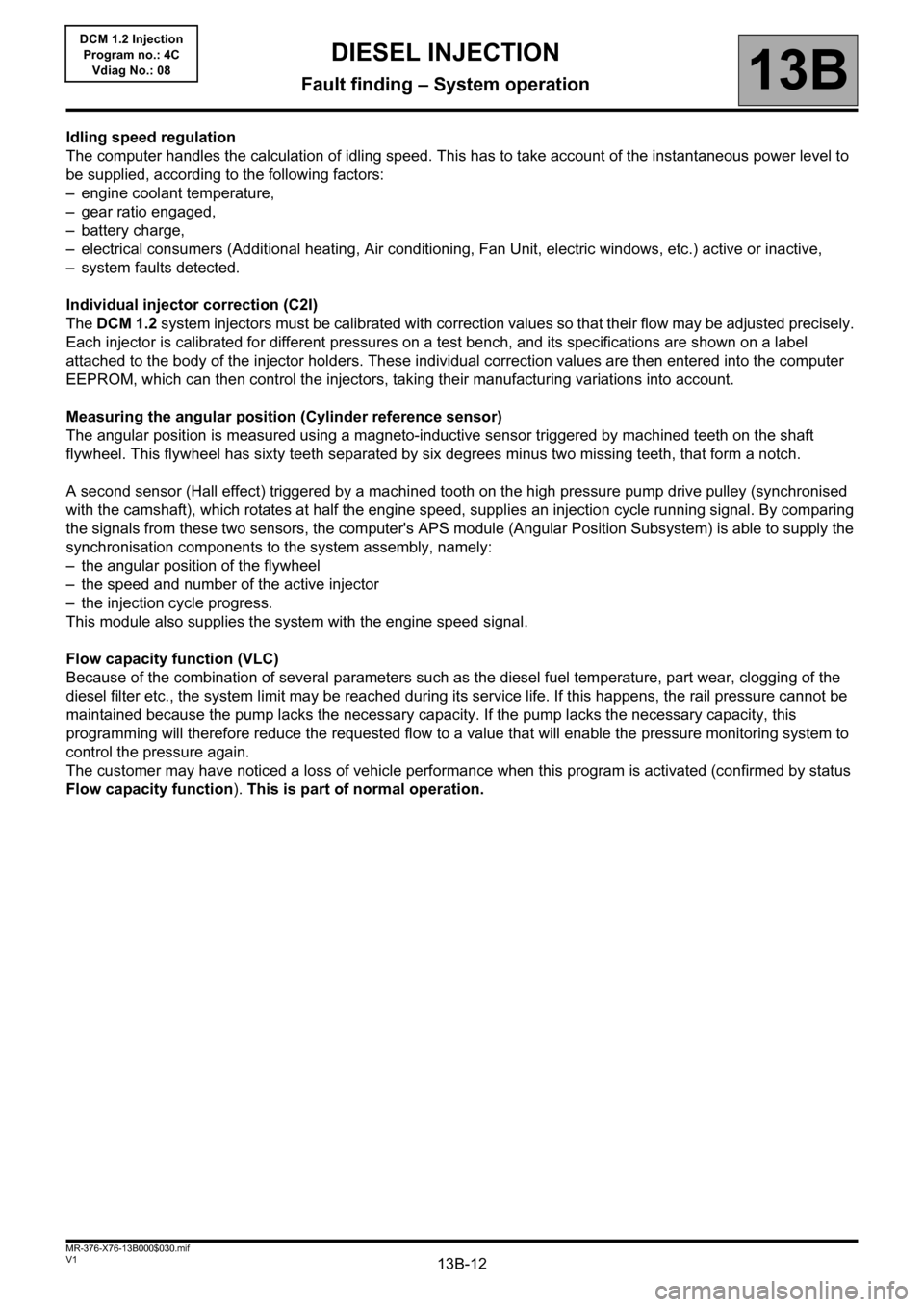
13B-12V1 MR-376-X76-13B000$030.mif
DIESEL INJECTION
Fault finding – System operation13B
DCM 1.2 Injection
Program no.: 4C
Vdiag No.: 08
Idling speed regulation
The computer handles the calculation of idling speed. This has to take account of the instantaneous power level to
be supplied, according to the following factors:
– engine coolant temperature,
– gear ratio engaged,
– battery charge,
– electrical consumers (Additional heating, Air conditioning, Fan Unit, electric windows, etc.) active or inactive,
– system faults detected.
Individual injector correction (C2I)
The DCM 1.2 system injectors must be calibrated with correction values so that their flow may be adjusted precisely.
Each injector is calibrated for different pressures on a test bench, and its specifications are shown on a label
attached to the body of the injector holders. These individual correction values are then entered into the computer
EEPROM, which can then control the injectors, taking their manufacturing variations into account.
Measuring the angular position (Cylinder reference sensor)
The angular position is measured using a magneto-inductive sensor triggered by machined teeth on the shaft
flywheel. This flywheel has sixty teeth separated by six degrees minus two missing teeth, that form a notch.
A second sensor (Hall effect) triggered by a machined tooth on the high pressure pump drive pulley (synchronised
with the camshaft), which rotates at half the engine speed, supplies an injection cycle running signal. By comparing
the signals from these two sensors, the computer's APS module (Angular Position Subsystem) is able to supply the
synchronisation components to the system assembly, namely:
– the angular position of the flywheel
– the speed and number of the active injector
– the injection cycle progress.
This module also supplies the system with the engine speed signal.
Flow capacity function (VLC)
Because of the combination of several parameters such as the diesel fuel temperature, part wear, clogging of the
diesel filter etc., the system limit may be reached during its service life. If this happens, the rail pressure cannot be
maintained because the pump lacks the necessary capacity. If the pump lacks the necessary capacity, this
programming will therefore reduce the requested flow to a value that will enable the pressure monitoring system to
control the pressure again.
The customer may have noticed a loss of vehicle performance when this program is activated (confirmed by status
Flow capacity function). This is part of normal operation.
Page 17 of 204
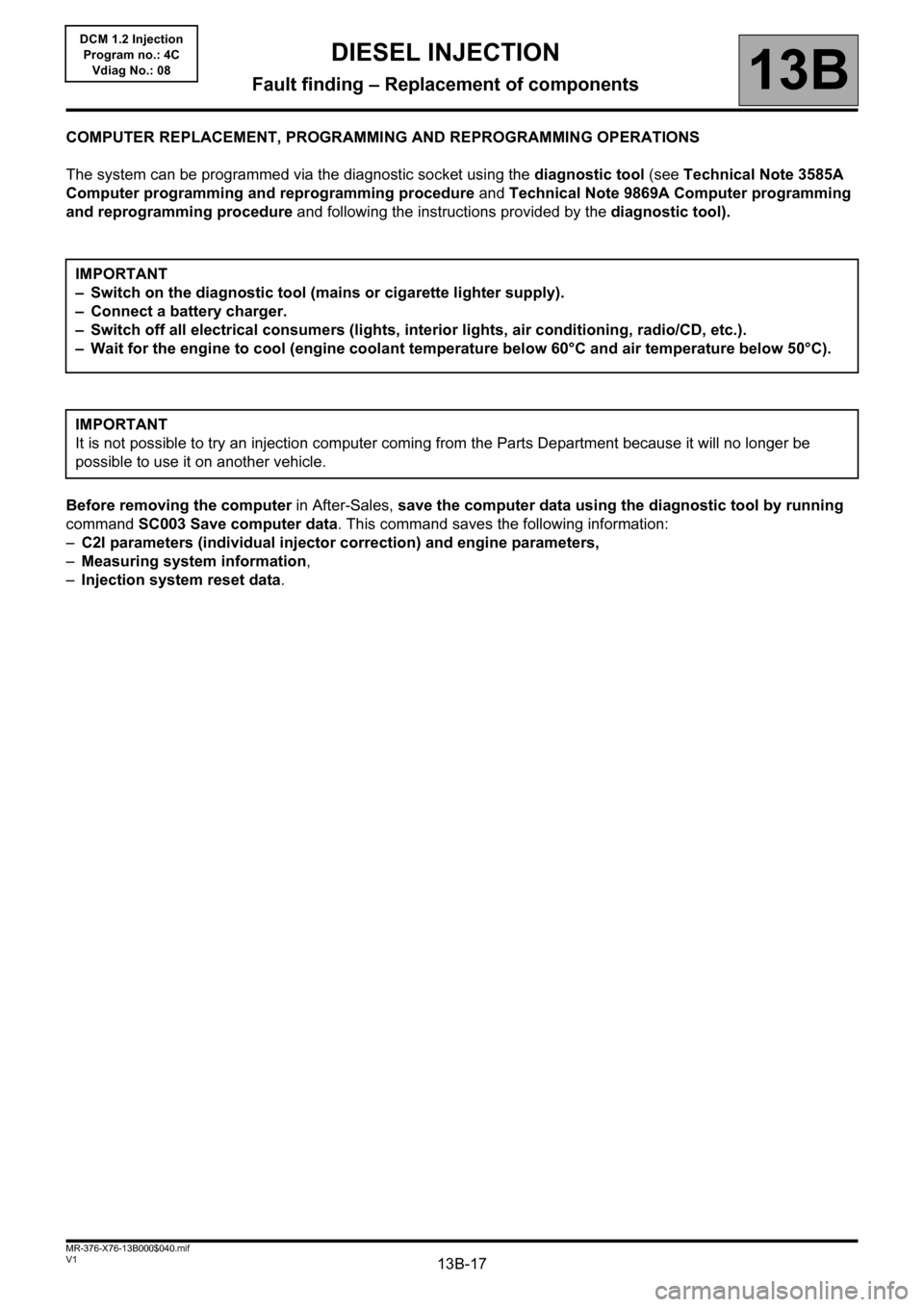
13B-17V1 MR-376-X76-13B000$040.mif
13B
DCM 1.2 Injection
Program no.: 4C
Vdiag No.: 08
COMPUTER REPLACEMENT, PROGRAMMING AND REPROGRAMMING OPERATIONS
The system can be programmed via the diagnostic socket using the diagnostic tool (see Technical Note 3585A
Computer programming and reprogramming procedure and Technical Note 9869A Computer programming
and reprogramming procedure and following the instructions provided by the diagnostic tool).
Before removing the computer in After-Sales, save the computer data using the diagnostic tool by running
command SC003 Save computer data. This command saves the following information:
–C2I parameters (individual injector correction) and engine parameters,
–Measuring system information,
–Injection system reset data. IMPORTANT
– Switch on the diagnostic tool (mains or cigarette lighter supply).
– Connect a battery charger.
– Switch off all electrical consumers (lights, interior lights, air conditioning, radio/CD, etc.).
– Wait for the engine to cool (engine coolant temperature below 60°C and air temperature below 50°C).
IMPORTANT
It is not possible to try an injection computer coming from the Parts Department because it will no longer be
possible to use it on another vehicle.
DIESEL INJECTION
Fault finding – Replacement of components
Page 18 of 204

13B-18V1 MR-376-X76-13B000$040.mif
DIESEL INJECTION
Fault finding – Replacement of components13B
DCM 1.2 Injection
Program no.: 4C
Vdiag No.: 08
After the computer has been programmed:
– Switch off the ignition.
– Switch on the ignition again and use the diagnostic tool to carry out the following steps:
– Use command SC001 Write saved data to restore the C2I and the engine adaptive programming.
– Run command VP010 Write VIN.
– Run command AC028 Static test.
– Run command AC154 Low speed fan assembly to test the operation of the 1st speed fan assembly.
– Run command AC153 High speed fan assembly to test the operation of the 2nd speed fan assembly.
– Run command AC250 Heating resistor 1 relay to test the operation of passenger compartment heating resistor 1.
– Run command AC251 Heating resistor 2 relay to test the operation of passenger compartment heating resistor 2.
– Run command AC100 Stop electrical consumer inhibition.
– Run command AC212 Fill new pump chamber.
– Run the starter motor without releasing the key until the engine starts (the pump reprime time until the engine starts
can be up to 20 seconds).
– After the engine has started, refer to ET637 Fill new pump chamber and check that it is Done; if not, repeat the
starting procedure.
–Stop the engine, switch off the ignition (to initialise the computer) and wait 30 seconds.
– After injection system programming, stored faults may appear in other computers.
– If DF1083 Water in diesel fuel warning light circuit appears in the injection computer: on a vehicle fitted with
a water in diesel fuel warning light, perform the fault finding operations described in DF1083 then run command
AC028 Static test; on other vehicles, do not deal with the fault.
– Clear the computer memory RZ001 Fault memory.
IMPORTANT
AFTER A (RE)PROGRAMMING OPERATION, DO NOT DISCONNECT THE BATTERY FOR AT LEAST
30 MINUTES (to carry out other work on the vehicle).
Note:
If commands SC003 Save computer data and SC001 Write saved data have been lost or do not work, after
programming the computer, enter the C2I for each injector manually by reading the C2I on each injector (see
Replacing the injectors).
Page 19 of 204
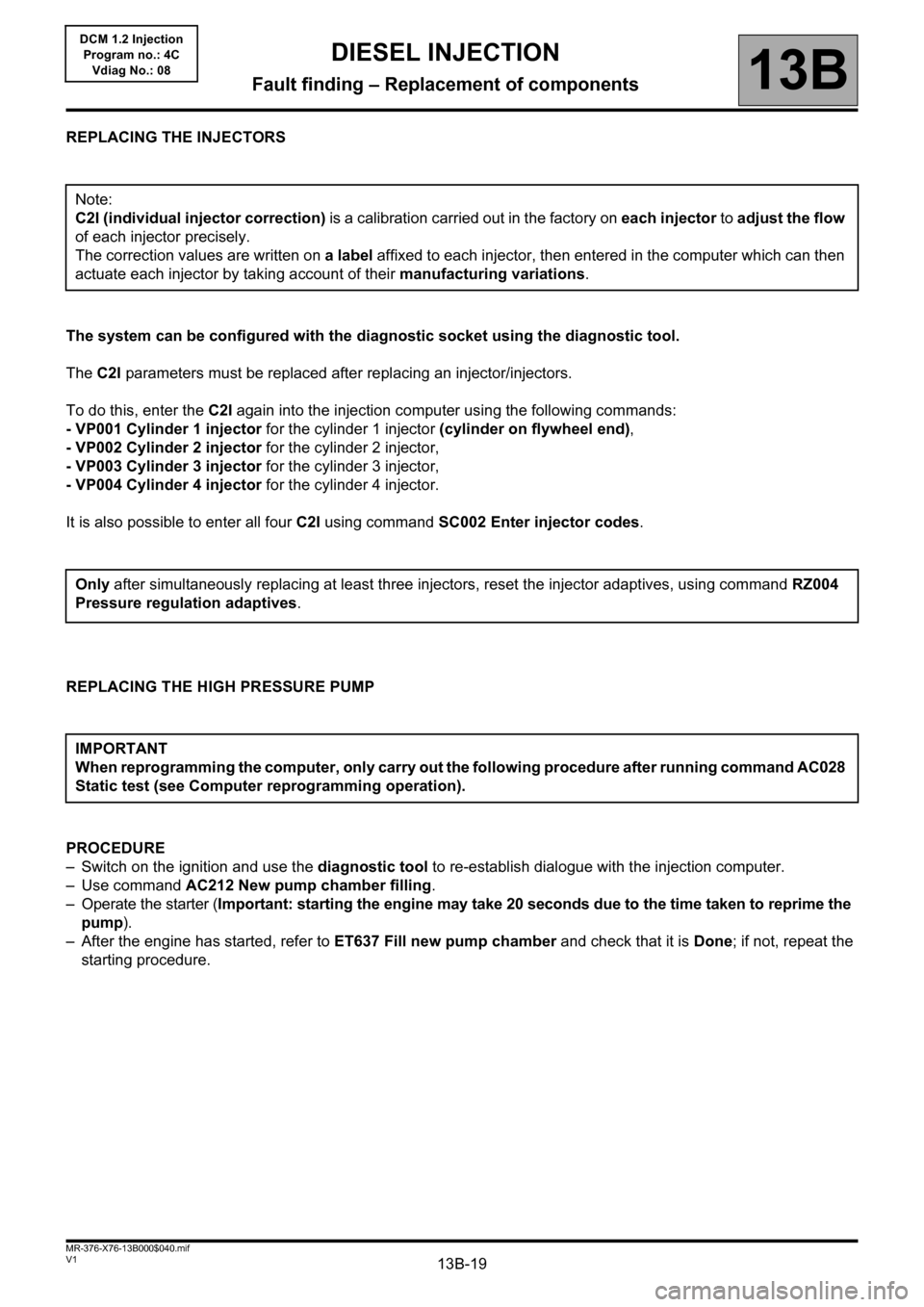
13B-19V1 MR-376-X76-13B000$040.mif
DIESEL INJECTION
Fault finding – Replacement of components13B
DCM 1.2 Injection
Program no.: 4C
Vdiag No.: 08
REPLACING THE INJECTORS
The system can be configured with the diagnostic socket using the diagnostic tool.
The C2I parameters must be replaced after replacing an injector/injectors.
To do this, enter the C2I again into the injection computer using the following commands:
- VP001 Cylinder 1 injector for the cylinder 1 injector (cylinder on flywheel end),
- VP002 Cylinder 2 injector for the cylinder 2 injector,
- VP003 Cylinder 3 injector for the cylinder 3 injector,
- VP004 Cylinder 4 injector for the cylinder 4 injector.
It is also possible to enter all four C2I using command SC002 Enter injector codes.
REPLACING THE HIGH PRESSURE PUMP
PROCEDURE
– Switch on the ignition and use the diagnostic tool to re-establish dialogue with the injection computer.
– Use command AC212 New pump chamber filling.
– Operate the starter (Important: starting the engine may take 20 seconds due to the time taken to reprime the
pump).
– After the engine has started, refer to ET637 Fill new pump chamber and check that it is Done; if not, repeat the
starting procedure. Note:
C2I (individual injector correction) is a calibration carried out in the factory on each injector to adjust the flow
of each injector precisely.
The correction values are written on a label affixed to each injector, then entered in the computer which can then
actuate each injector by taking account of their manufacturing variations.
Only after simultaneously replacing at least three injectors, reset the injector adaptives, using command RZ004
Pressure regulation adaptives.
IMPORTANT
When reprogramming the computer, only carry out the following procedure after running command AC028
Static test (see Computer reprogramming operation).
Page 21 of 204

13B-21V1 MR-376-X76-13B000$050.mif
13B
DCM 1.2 Injection
Program no.: 4C
Vdiag No.: 08
SETTINGS
VP001: Cylinder 1 injector
VP002: Cylinder 2 injector
VP003: Cylinder 3 injector
VP004: Cylinder 4 injector
These commands enable you to manually write the calibration code marked on the injector.
Use these commands after replacing the injector or replacing or (re)programming the computer, when
command SC001 Write saved data does not work.
VP010: Write VIN.
This command enables the vehicle VIN to be entered into the computer.
Use this command each time the computer is replaced or (re)programmed.
VP013: Lock injector control.
This command disables electrical actuation of the injectors, for carrying out the compression test.
SPECIAL COMMANDS
SC001: Write saved data.
Use this command after replacing or (re)programming the computer (if the data were saved using
command SC003 Save computer data).
SC002: Enter injector codes.
This command enables you to manually write the calibration code marked on the injectors.
Use this command after replacing the injectors.
SC003: Save computer data.
This command saves the computer operating data, C2I (individual injector correction) parameters
and engine programming adapters.
Use this command before replacing or (re)programming a computer.
DIESEL INJECTION
Fault finding – Configurations and programming
Page 24 of 204
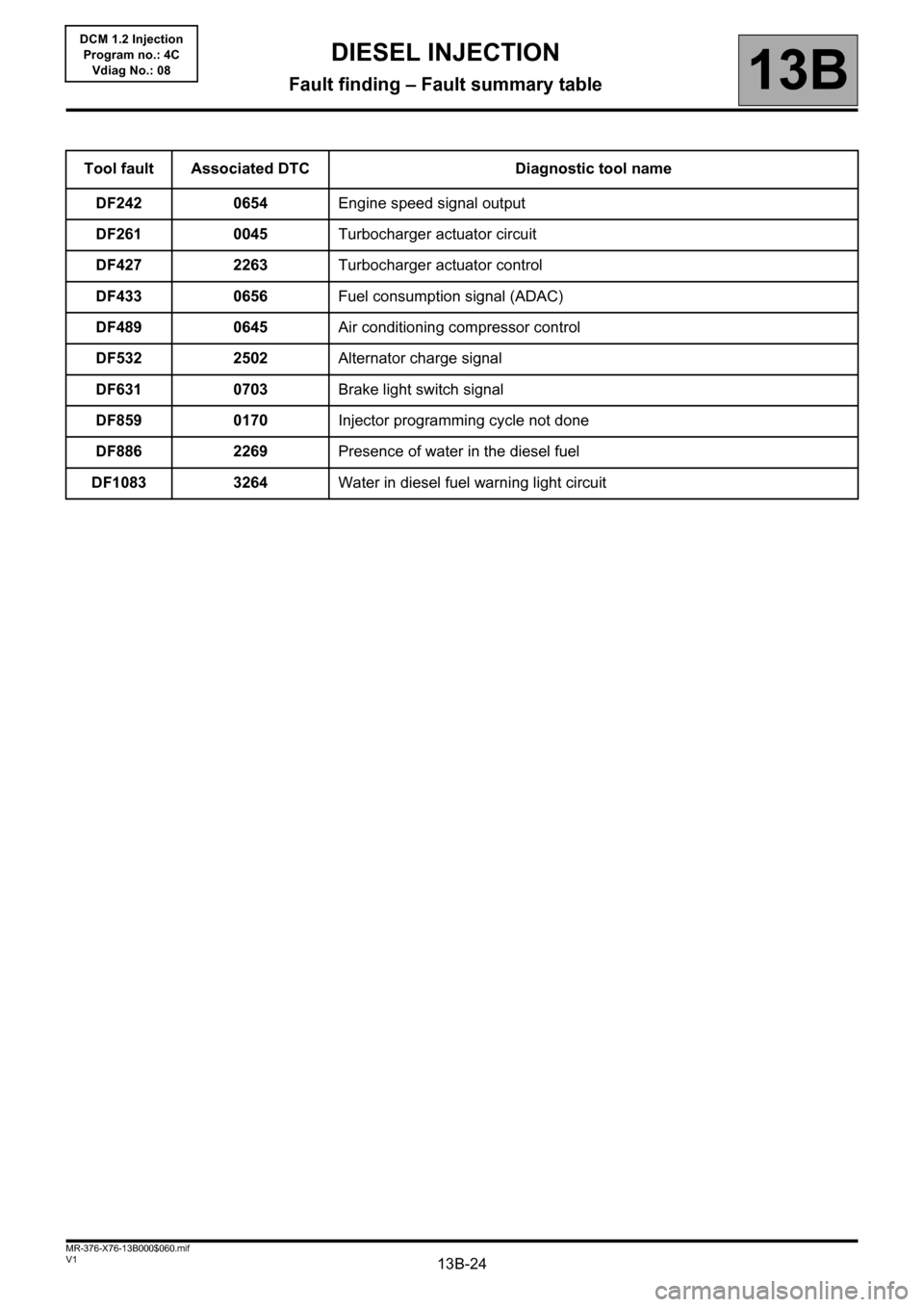
13B-24V1 MR-376-X76-13B000$060.mif
DIESEL INJECTION
Fault finding – Fault summary table13B
DCM 1.2 Injection
Program no.: 4C
Vdiag No.: 08
Tool fault Associated DTC Diagnostic tool name
DF242 0654Engine speed signal output
DF261 0045Turbocharger actuator circuit
DF427 2263Turbocharger actuator control
DF433 0656Fuel consumption signal (ADAC)
DF489 0645Air conditioning compressor control
DF532 2502Alternator charge signal
DF631 0703Brake light switch signal
DF859 0170Injector programming cycle not done
DF886 2269Presence of water in the diesel fuel
DF1083 3264Water in diesel fuel warning light circuit
Page 55 of 204
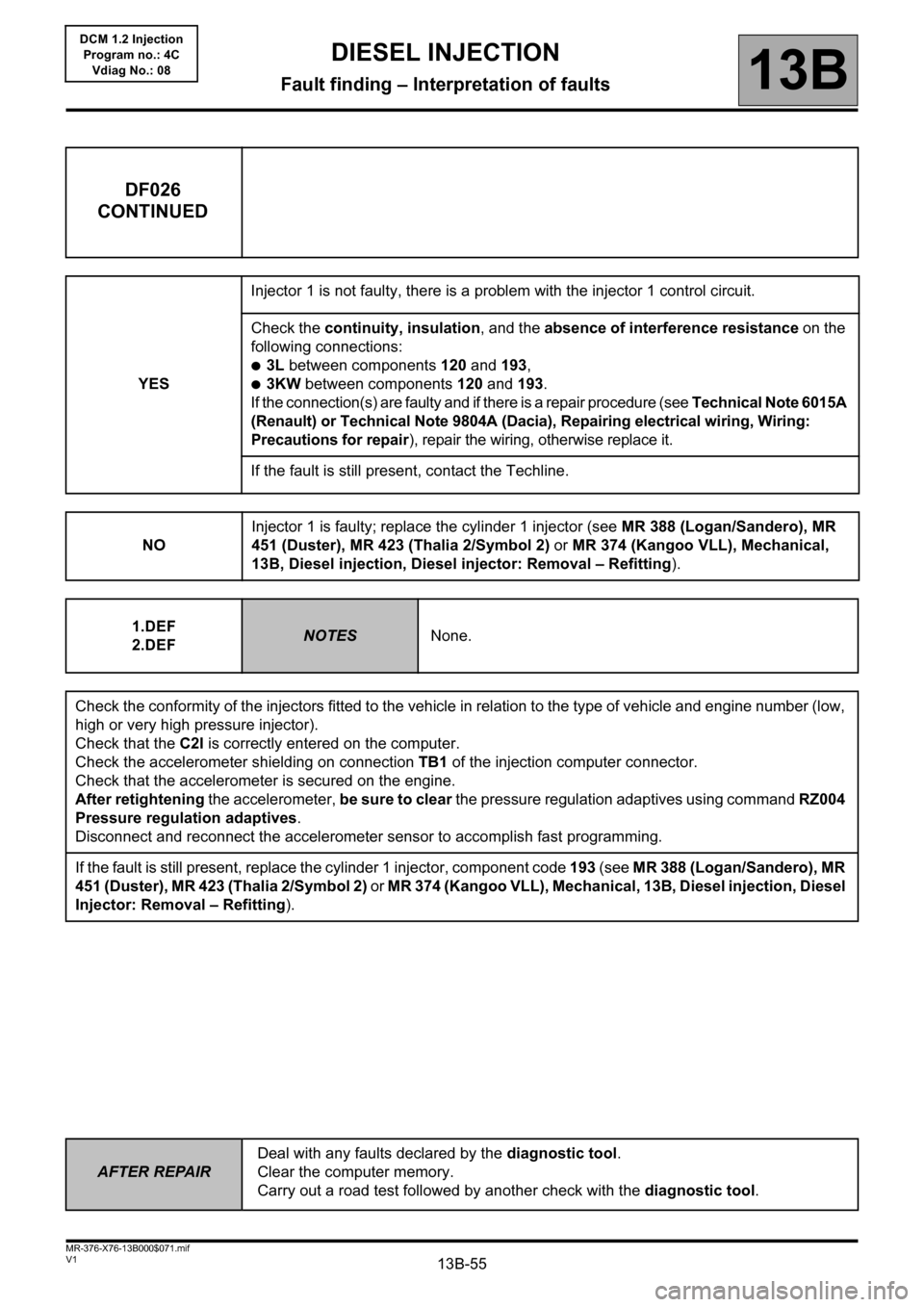
13B-55
AFTER REPAIRDeal with any faults declared by the diagnostic tool.
Clear the computer memory.
Carry out a road test followed by another check with the diagnostic tool.
V1 MR-376-X76-13B000$071.mif
DIESEL INJECTION
Fault finding – Interpretation of faults13B
DCM 1.2 Injection
Program no.: 4C
Vdiag No.: 08
DF026
CONTINUED
YESInjector 1 is not faulty, there is a problem with the injector 1 control circuit.
Check the continuity, insulation, and the absence of interference resistance on the
following connections:
●3L between components 120 and 193,
●3KW between components 120 and 193.
If the connection(s) are faulty and if there is a repair procedure (see Technical Note 6015A
(Renault) or Technical Note 9804A (Dacia), Repairing electrical wiring, Wiring:
Precautions for repair), repair the wiring, otherwise replace it.
If the fault is still present, contact the Techline.
NOInjector 1 is faulty; replace the cylinder 1 injector (see MR 388 (Logan/Sandero), MR
451 (Duster), MR 423 (Thalia 2/Symbol 2) or MR 374 (Kangoo VLL), Mechanical,
13B, Diesel injection, Diesel injector: Removal – Refitting).
1.DEF
2.DEF
NOTESNone.
Check the conformity of the injectors fitted to the vehicle in relation to the type of vehicle and engine number (low,
high or very high pressure injector).
Check that the C2I is correctly entered on the computer.
Check the accelerometer shielding on connection TB1 of the injection computer connector.
Check that the accelerometer is secured on the engine.
After retightening the accelerometer, be sure to clear the pressure regulation adaptives using command RZ004
Pressure regulation adaptives.
Disconnect and reconnect the accelerometer sensor to accomplish fast programming.
If the fault is still present, replace the cylinder 1 injector, component code 193 (see MR 388 (Logan/Sandero), MR
451 (Duster), MR 423 (Thalia 2/Symbol 2) or MR 374 (Kangoo VLL), Mechanical, 13B, Diesel injection, Diesel
Injector: Removal – Refitting).
Page 57 of 204
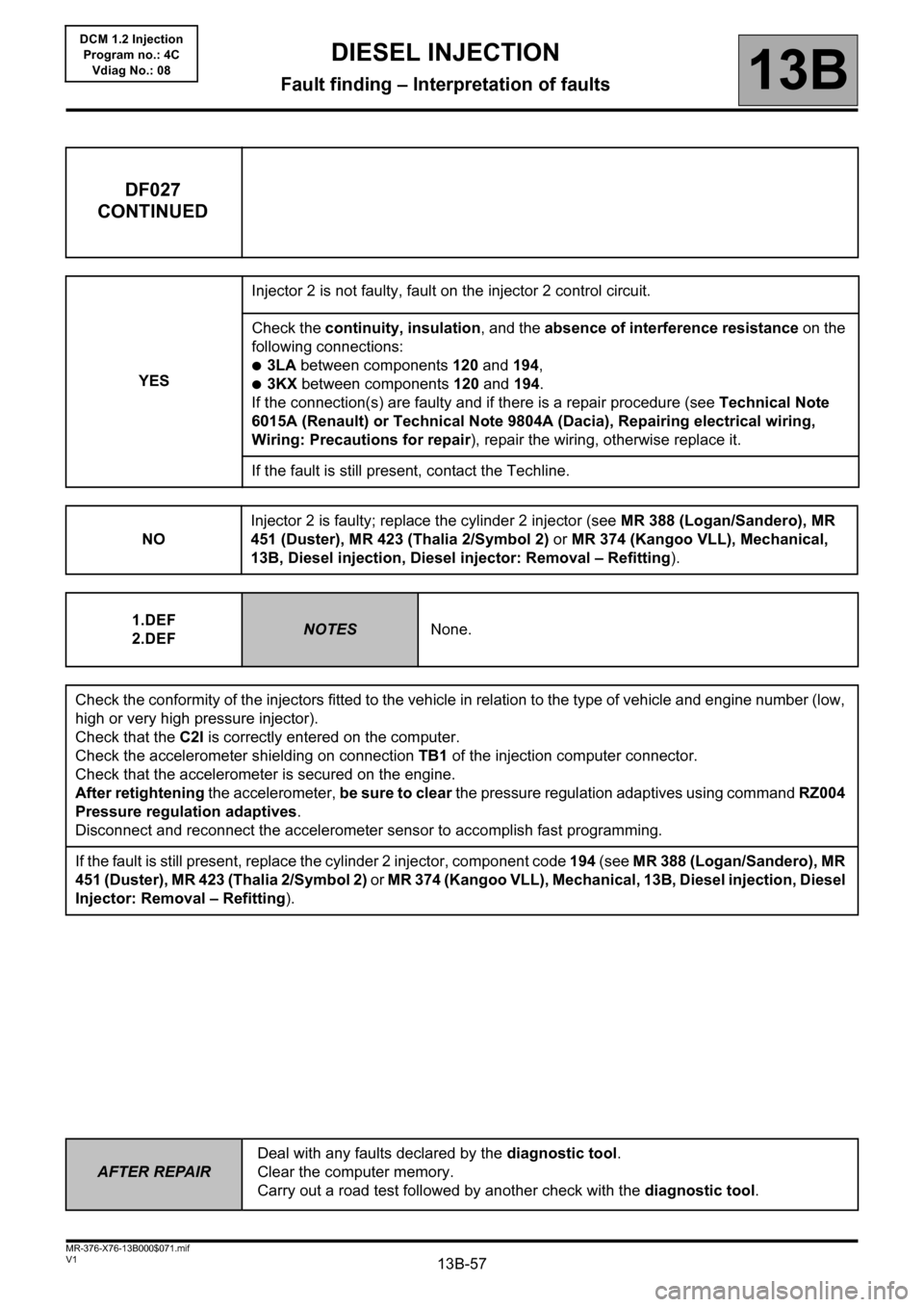
13B-57
AFTER REPAIRDeal with any faults declared by the diagnostic tool.
Clear the computer memory.
Carry out a road test followed by another check with the diagnostic tool.
V1 MR-376-X76-13B000$071.mif
DIESEL INJECTION
Fault finding – Interpretation of faults13B
DCM 1.2 Injection
Program no.: 4C
Vdiag No.: 08
DF027
CONTINUED
YESInjector 2 is not faulty, fault on the injector 2 control circuit.
Check the continuity, insulation, and the absence of interference resistance on the
following connections:●3LA between components 120 and 194,
●3KX between components 120 and 194.
If the connection(s) are faulty and if there is a repair procedure (see Technical Note
6015A (Renault) or Technical Note 9804A (Dacia), Repairing electrical wiring,
Wiring: Precautions for repair), repair the wiring, otherwise replace it.
If the fault is still present, contact the Techline.
NOInjector 2 is faulty; replace the cylinder 2 injector (see MR 388 (Logan/Sandero), MR
451 (Duster), MR 423 (Thalia 2/Symbol 2) or MR 374 (Kangoo VLL), Mechanical,
13B, Diesel injection, Diesel injector: Removal – Refitting).
1.DEF
2.DEF
NOTESNone.
Check the conformity of the injectors fitted to the vehicle in relation to the type of vehicle and engine number (low,
high or very high pressure injector).
Check that the C2I is correctly entered on the computer.
Check the accelerometer shielding on connection TB1 of the injection computer connector.
Check that the accelerometer is secured on the engine.
After retightening the accelerometer, be sure to clear the pressure regulation adaptives using command RZ004
Pressure regulation adaptives.
Disconnect and reconnect the accelerometer sensor to accomplish fast programming.
If the fault is still present, replace the cylinder 2 injector, component code 194 (see MR 388 (Logan/Sandero), MR
451 (Duster), MR 423 (Thalia 2/Symbol 2) or MR 374 (Kangoo VLL), Mechanical, 13B, Diesel injection, Diesel
Injector: Removal – Refitting).
Page 59 of 204

13B-59
AFTER REPAIRDeal with any faults declared by the diagnostic tool.
Clear the computer memory.
Carry out a road test followed by another check with the diagnostic tool.
V1 MR-376-X76-13B000$071.mif
DIESEL INJECTION
Fault finding – Interpretation of faults13B
DCM 1.2 Injection
Program no.: 4C
Vdiag No.: 08
DF028
CONTINUED
YESInjector 3 is not faulty, fault on injector 3 control circuit.
Check the continuity, insulation, and the absence of interference resistance on the
following connections:
●3LB between components 120 and 195,
●3KY between components 120 and 195.
If the connection(s) are faulty and if there is a repair procedure (see Technical Note 6015A
(Renault) or Technical Note 9804A (Dacia), Repairing electrical wiring, Wiring:
Precautions for repair), repair the wiring, otherwise replace it.
If the fault is still present, contact the Techline.
NOInjector 3 is faulty; replace the cylinder 3 injector (see MR 388 (Logan/Sandero), MR
451 (Duster), MR 423 (Thalia 2/Symbol 2) or MR 374 (Kangoo VLL), Mechanical,
13B, Diesel injection, Diesel injector: Removal – Refitting).
1.DEF
2.DEF
NOTESNone.
Check the conformity of the injectors fitted to the vehicle in relation to the vehicle type and engine number (low,
high or very high pressure injector).
Check that the C2I is correctly entered on the computer.
Check the accelerometer shielding on connection TB1 of the injection computer connector, component code 120.
Check that the accelerometer is secured on the engine.
After retightening the accelerometer, be sure to clear the pressure regulation adaptives using command RZ004
Pressure regulation adaptives.
Disconnect and reconnect the accelerometer sensor to accomplish fast programming.
If the fault is still present, replace the cylinder 3 injector, component code 195 (see MR 388 (Logan/Sandero), MR
451 (Duster), MR 423 (Thalia 2/Symbol 2) or MR 374 (Kangoo VLL), Mechanical, 13B, Diesel injection, Diesel
Injector: Removal – Refitting).